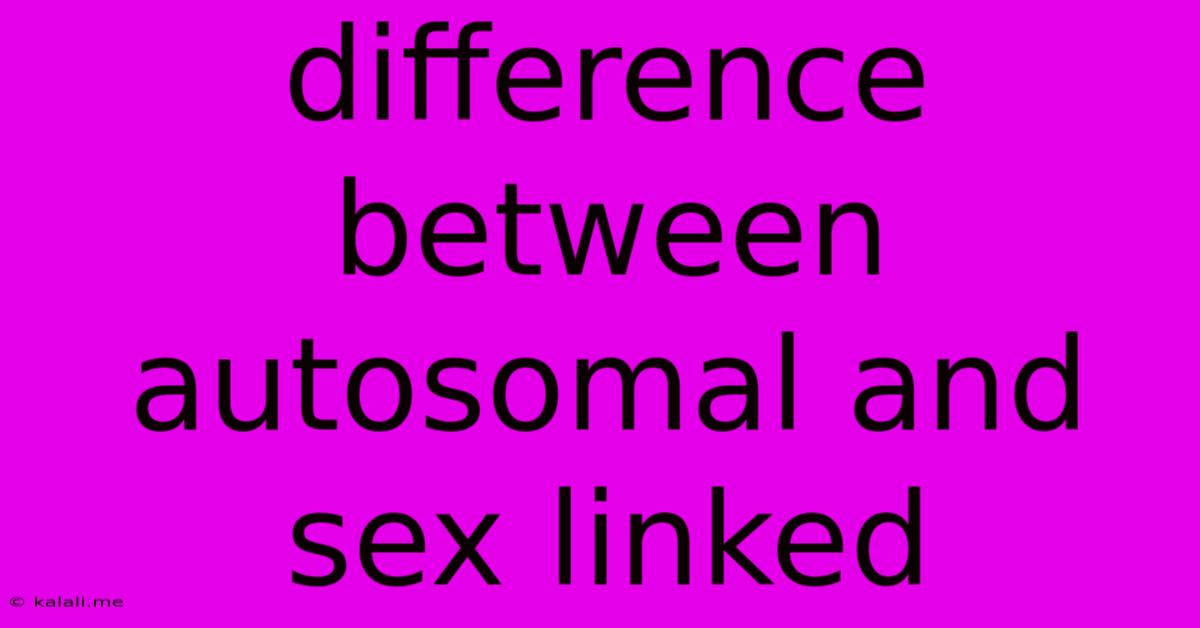Difference Between Autosomal And Sex Linked
Kalali
May 09, 2025 · 3 min read

Table of Contents
Autosomal vs. Sex-Linked Traits: Understanding the Difference
Understanding the difference between autosomal and sex-linked inheritance is crucial for comprehending basic genetics. This article will clearly explain the key distinctions, providing examples to illustrate the concepts. We'll explore how genes located on autosomes differ from those situated on sex chromosomes, impacting the inheritance patterns observed in offspring.
What are Autosomes and Sex Chromosomes?
Before delving into the differences, let's define our terms. Humans have 23 pairs of chromosomes: 22 pairs of autosomes and one pair of sex chromosomes. Autosomes are chromosomes that don't determine sex. They carry a vast majority of our genes, responsible for various traits like eye color, hair color, height, and many more. Sex chromosomes, on the other hand, determine an individual's sex. Females typically have two X chromosomes (XX), while males have one X and one Y chromosome (XY).
Autosomal Inheritance:
Autosomal inheritance refers to the inheritance of genes located on autosomes. This means that both males and females have an equal chance of inheriting the trait. There are two main patterns:
-
Autosomal Dominant: Only one copy of the mutated gene is needed to express the trait. Affected individuals usually have at least one affected parent. Examples include Huntington's disease and achondroplasia. The trait typically appears in every generation.
-
Autosomal Recessive: Two copies of the mutated gene are required for the trait to manifest. Affected individuals often have unaffected parents who are carriers (possessing one mutated and one normal gene). Examples include cystic fibrosis and sickle cell anemia. The trait may skip generations.
Sex-Linked Inheritance:
Sex-linked inheritance refers to the inheritance of genes located on the sex chromosomes, primarily the X chromosome (X-linked inheritance is far more common than Y-linked). Because males only have one X chromosome, they are more susceptible to X-linked recessive disorders. Females, with two X chromosomes, require two copies of the mutated gene to express the trait.
-
X-linked Recessive: Males only need one copy of the mutated gene on their single X chromosome to show the trait. Females need two copies. Examples include hemophilia and color blindness. Affected males usually have carrier mothers. The trait is typically passed from affected fathers to their daughters (who become carriers).
-
X-linked Dominant: Only one copy of the mutated gene is needed for expression in both males and females. Affected fathers will pass the trait to all of their daughters. Affected mothers will pass the trait to approximately half of their daughters and sons. Examples are less common than X-linked recessive disorders.
-
Y-linked Inheritance: Traits are only passed from father to son, as only males possess the Y chromosome. These traits are rare.
Key Differences Summarized:
| Feature | Autosomal Inheritance | Sex-Linked Inheritance |
|---|---|---|
| Chromosome Location | Autosomes | Sex chromosomes (X or Y) |
| Male/Female Ratio | Equal | Unequal (usually more males affected in X-linked recessive) |
| Inheritance Pattern | Dominant or Recessive | Dominant or Recessive (X-linked is more common) |
| Transmission | Both parents contribute equally | Mother's contribution more significant in X-linked recessive |
Conclusion:
Understanding the difference between autosomal and sex-linked inheritance is essential for predicting the likelihood of a trait appearing in offspring. By recognizing the patterns of inheritance, genetic counselors and healthcare professionals can provide accurate risk assessments and appropriate medical guidance. This knowledge also forms the cornerstone for advancements in genetic research and disease management.
Latest Posts
Latest Posts
-
Lowest Common Denominator For 3 4 5
Jul 14, 2025
-
Can You Be A Professor With A Masters
Jul 14, 2025
-
How Many Bottles Of Water Is 1 Liter
Jul 14, 2025
-
How Many Days In A Million Minutes
Jul 14, 2025
-
How Many Days Is In 11 Weeks
Jul 14, 2025
Related Post
Thank you for visiting our website which covers about Difference Between Autosomal And Sex Linked . We hope the information provided has been useful to you. Feel free to contact us if you have any questions or need further assistance. See you next time and don't miss to bookmark.